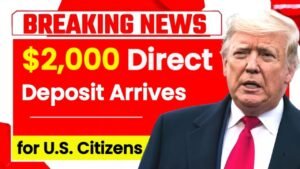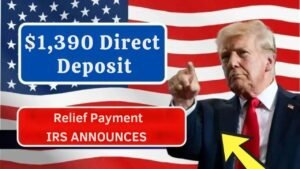Rumors about a $2,000 direct deposit hitting bank accounts in November 2025 have taken over social media and news outlets. With rising costs for groceries, rent, utilities, and healthcare, it’s no wonder Americans are asking:
“Is this $2,000 payment real and officially approved?”
Here’s a clear, fact-checked guide separating official updates from online speculation, explaining what’s confirmed, potential eligibility, and what citizens can do now.
Is the $2,000 November 2025 Payment Official?
Currently, no federal approval exists for a $2,000 direct deposit in November 2025.
Key points:
- Discussions about this payment stem from policy proposals, economic suggestions, and online rumors.
- No law or federal announcement guarantees this payment.
- Any nationwide financial assistance would require Congressional approval, funding allocation, and a public announcement.
In short, while the idea is trending, it is not an approved federal program—yet.
Why Is the $2,000 Payment Being Discussed?
Economic challenges are driving conversations about potential financial relief:
- Rising food, fuel, and utility costs
- Increasing rent and mortgage payments
- Interest rates climbing
- Slow wage growth compared to inflation
- Financial strain on seniors, veterans, and low-income families
These factors have led policymakers and advocacy groups to consider additional support. However, public discussion does not equal official approval.
Possible Eligibility (If Approved)
While no official rules exist, past federal relief efforts suggest these potential eligibility criteria:
- U.S. citizenship or legal residency
- Income limits based on tax filings
- Social Security (SS), SSI, SSDI, or VA benefit recipients
- Updated tax return and direct deposit information
- Household size, dependents, and age group
If a program is approved, agencies like the IRS would use existing records to verify eligibility.
How Payments Could Be Delivered
If approved, distribution might follow previous federal relief methods:
- Direct deposit (fastest and most secure)
- Paper checks mailed to the IRS or SSA address
- Prepaid debit cards for those without a bank account
- Verification through a government portal, if required
Citizens should ensure banking information with the IRS is accurate to prevent delays.
Expected Payment Dates (If Approved)
No confirmed schedule exists. For payments to occur, the government would need to complete:
- Official approval or legislation
- Funding allocation
- Public announcement and instructions
- Confirmed rollout schedule
Until these steps happen, no exact date can be guaranteed.
Beware of Scams
Financial aid rumors often attract scammers. Avoid:
- Fake registration websites
- Fraudulent apps claiming “early access”
- Sites asking for banking information or fees
- Social media posts promising guaranteed payments
The government never charges a fee for relief payments.
FAQs About the $2,000 November Payment
1. Is this payment officially approved?
No. Currently, there is no federal program guaranteeing this payment.
2. Will all U.S. citizens automatically receive it?
No. Any future program would have specific eligibility rules.
3. Do I need to apply online?
No. Avoid third-party websites. Official instructions come only from federal agencies.
4. Will Social Security, SSI, SSDI, or VA recipients qualify?
Past programs included them, but future eligibility is not defined.
5. Should I update any information now?
Yes. Keep your tax records, mailing address, and direct deposit details current.
6. Where to check for updates?
Only use official sites: IRS.gov, SSA.gov, VA.gov, USA.gov.
Conclusion: Stay Informed and Cautious
The idea of a $2,000 direct deposit in November 2025 has captured public attention, but no confirmed program or payment schedule exists. Until the federal government issues an official announcement, treat viral posts and online claims with caution. Keep records up-to-date, avoid scams, and follow official government sources for the latest verified information.





